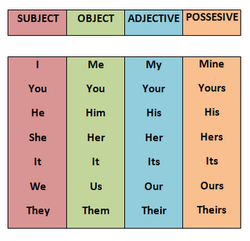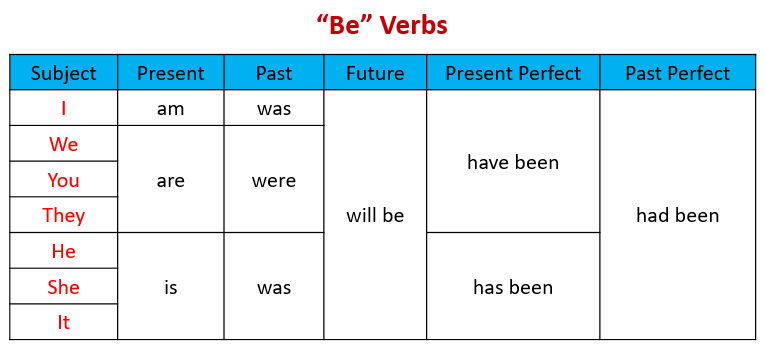![]() Part 1 名詞Nouns
Part 1 名詞Nouns
![]() 單數 singular & 複數 plural 名詞
單數 singular & 複數 plural 名詞

圖片來源 中市數位教學資源單 ![]() https://etoe.tc.edu.tw/index/vrs/did/30616
https://etoe.tc.edu.tw/index/vrs/did/30616
|
規則變化: |
|||
|
原則 |
單數名詞 |
複數名詞 |
|
|
大部分名詞的複數都是在單數名詞後面 ______。 |
book |
books |
|
|
girl |
girl___ |
||
|
字母以-ch, -sh, -s, -x, -o收尾的單數名詞,寫成 複數時要加上 ______。
(例外:photo → photos) |
bus |
buses |
|
|
box |
box_____ |
||
|
brush |
brush_____ |
||
|
potato |
potato_____ |
||
|
最後兩個字母是子音+y的名詞,改寫成要 去y加___ _。 (例外:y前面是母音aeiou時直接+s ( toy → toys ) <母愛最偉大請勿砍母音!!> |
baby |
babies |
|
|
lady |
lad_____ |
||
|
不規則變化: |
|||
|
字母以-f或是-fe結尾的名詞,去f或fe加ves。 |
wife |
wives |
|
圖片來源 中市數位教學資源單 ![]() https://etoe.tc.edu.tw/index/vrs/did/27834
https://etoe.tc.edu.tw/index/vrs/did/27834
![]() 發音規則:
發音規則:
1. 字尾是無聲子音,發/s/ ex: cats
2. 字尾是有聲子音或母音發/z/ ex: dogs
3. 加es, 發/IZ/ ex: watches
![]() 恆為複數的名詞
恆為複數的名詞
![]() 集合名詞為用來指稱人、事、物的「全體」名詞,欲強調群體中每個個體時,便是以「複數動詞」表示。在英式英文中,以單數或複數表達並無太大差異,而美式英文則偏好使用單數動詞。
集合名詞為用來指稱人、事、物的「全體」名詞,欲強調群體中每個個體時,便是以「複數動詞」表示。在英式英文中,以單數或複數表達並無太大差異,而美式英文則偏好使用單數動詞。
- clothes 衣服 由一塊一塊布料 (cloth) 組成
- pants 長褲 (美式)
- trousers 長褲 (英式)
- jeans 牛仔褲
- pajamas 睡衣
- shorts 短褲
- glasses 眼鏡
- binoculars 望遠鏡
- contact lenses 隱形眼鏡
- scissors 剪刀
- headphones 耳機
- clippers 指甲剪
- goggles 蛙鏡
- goods 物品
- savings 存款
- lyrics 歌詞
- police 警察
- progeny 後代
- people 人
- cattle 牛群
- vermin 害蟲
- personnel 人員
- poultry 家禽
參考資料![]() https://tw.blog.voicetube.com/archives/56230/
https://tw.blog.voicetube.com/archives/56230/
![]() 不可數uncountable 名詞 & 量詞 MEASURE WORDS
不可數uncountable 名詞 & 量詞 MEASURE WORDS

![]() 普通名詞 COMMON & 專有名詞 PROPER
普通名詞 COMMON & 專有名詞 PROPER
普通名詞用於指一般而不特定的人、事、物。普通名詞的第一個字母不須大寫,除非該名詞放在句首。
專有名詞係用於表示特定的人或物,專有名詞第一個字母必須大寫,如人名、國家、城市、地名、機構等屬於專有名詞。
![]() Part2 冠詞The Articles
Part2 冠詞The Articles
 不定冠詞(Indefinite Articles In English) : a和an,一般情況下,an接第一個音節為元音(母音)發音的單字,而第一個音節不是元音(母音)發音的單字則是加上a,通常以第一個字母是元音(母音)或是輔音(子音)來判斷,
不定冠詞(Indefinite Articles In English) : a和an,一般情況下,an接第一個音節為元音(母音)發音的單字,而第一個音節不是元音(母音)發音的單字則是加上a,通常以第一個字母是元音(母音)或是輔音(子音)來判斷,
可數名詞 - 沒有指定 - 一個 : a / an : 例如: 職業 she is a teacher/ 國籍 I am a Korean / 感嘆語氣 what a pretty girl she is.
![]() 定冠詞(Definite Article In English) : the在意義上可能表達this(這個)、that(那個)、these(這些)、those(那些),所以the後面可以加名詞的單數或複數 ; 定冠詞放在名詞之前,即能表達所指稱的事物是特定的(可能是先前的對話或句子已經提到過)。
定冠詞(Definite Article In English) : the在意義上可能表達this(這個)、that(那個)、these(這些)、those(那些),所以the後面可以加名詞的單數或複數 ; 定冠詞放在名詞之前,即能表達所指稱的事物是特定的(可能是先前的對話或句子已經提到過)。
獨一無二 the earth / 樂器 the piano / 姓氏 the Smiths /
![]() 不加冠詞
不加冠詞
集體名詞 / 專有名詞 / 名字 ( 州+城市+路) / 學科 / 三餐 / 季節 / 疾病
![]() Part3 量詞Quantifiers
Part3 量詞Quantifiers
![]() 量詞,顧名思義是表數量(但沒有指出明確數目)的詞。它是一種限定詞,通常置於名詞前面。
量詞,顧名思義是表數量(但沒有指出明確數目)的詞。它是一種限定詞,通常置於名詞前面。
many / Both / (a) few / fewer / several / a couple of / hundreds of / thousands of / none of 只能用於複數可數名詞,
little / a little / (not) much / a bit of / a good deal of / a great deal of 只能用於不可數名詞,
some, any, enough, lots of 等則可以同時用於複數可數名詞與不可數名詞。
![]() More examples
More examples
1. SOME & ANY
some + 直述句 & 請求性質的問句
any + 問句 & 否定句
2. 直述句 : few + 可數名詞 / little + 不可數名詞
a little / a few -> 有尚且足夠的量
little / few -> 有等於沒有
3. MANY + 可數名詞 & MUCH+ 不可數名詞
4. EACH / EVERY + 單數可數名詞 + 單數動詞
5. all / none of the / no + 複數可數名詞 + 複數動詞
all / no + 不可數名詞 + 複數動詞
6. a number of +複數名詞 + 複數動詞
the number of + 複數名詞 + 複數動詞
![]() Part4 代名詞Pronouns
Part4 代名詞Pronouns

photo credit ![]() http://scottteacher.weebly.com/subjectobject-pronouns-possessive-adjectives.html
http://scottteacher.weebly.com/subjectobject-pronouns-possessive-adjectives.html
![]() reflexive pronoun
reflexive pronoun
|
單 數 |
複 數 |
|
myself (我自己) |
ourselves (我們自己) |
|
yourself (你自己) |
yourselves (你們自己) |
|
himself (他自己) |
themselves (他們自己) |
|
herself (她自己) |
|
|
itself (它自己) |
![]() Part5 形容詞Adjectives
Part5 形容詞Adjectives
| 冠詞 | 次序 | 數字 | 性質 | 尺寸 | 外型 | 年紀 | 顏色 | 國籍 | 材質 |
|
the my a |
first second |
one two |
good bad |
fat long |
round oval |
old young |
red blue |
Chinese French |
mental olastic |
![]() Part6 動詞Verbs
Part6 動詞Verbs
![]() 及物動詞(transitive verb) : 及物動詞後面需要接受詞 : 主詞 (Subject) + 動詞 (Verb) + 受詞 (Object)
及物動詞(transitive verb) : 及物動詞後面需要接受詞 : 主詞 (Subject) + 動詞 (Verb) + 受詞 (Object)
- You lifted the bag.
- I punished you.
- I gave you the book.
- John traded his apple and Jane's orange with her.
- I ate the pie.
- I tried on the shoes.
![]() 不及物動詞(intransitive verb)
不及物動詞(intransitive verb)
| appear 顯露,似乎 | arrive 到達 | belong 屬(於) |
| bloom 開花 | care 在乎;關心 | collapse 倒塌 |
| cough 咳 | cry 哭 | depend 依賴 |
| die 死去;過世 | disappear 消失 | emerge 浮現 |
| exist 存在 | fall 落下,跌倒 | happen 發生 |
| last 持續 | lie 躺 | look 看,瞧 |
| matter 要緊;重要 | occur 發生 | remain 保持;仍是 |
| respond 回應 | result 結果;導致 | rise 上升 |
| sleep 睡 | smile 微笑;笑 | sneeze 打噴嚏 |
| stand 站立 | stay 停留;保持 | swim 游泳 |
| tremble 發抖;搖晃 | vanish 消逝 | wait 等;等待 |
![]() BE VERB
BE VERB

PHOTO CREDIT ![]() https://www.onlinemathlearning.com/verb-be.html
https://www.onlinemathlearning.com/verb-be.html
![]() HAVE
HAVE
![]() 連綴動詞 LINKING VERB
連綴動詞 LINKING VERB
| 常見連綴動詞範例 | |
|---|---|
| Be動詞 | am, is, are, was, were, be, being, been, will be, would be, would have been, shall be, should be, should have been, may be, might be, might have been, can be, could be, could have been |
| 似乎 | seem (似乎;仿佛), appear (呈現;顯現) |
| 仍然 | remain (仍然是), stay (繼續;保持), keep ((使)保持(某狀態)) |
| 變得 | become (變得), grow (成長), turn (變得), go (變成,成為),get (變成;變得) |
| …起來 | look (看起來), feel (感覺起來), smell (聞起來), sound (聽起來), taste (嚐起來) |
| 其他 | stand (處於...狀態), prove (證明是) |
![]() 資料來源: 台灣測驗中心
資料來源: 台灣測驗中心
![]() 非限定動詞 ( NON-FINITE VERB)
非限定動詞 ( NON-FINITE VERB)
1. 動名詞 GERUNDS - VING
表達感覺: LIKE / LOVE/ ENJOY/HAT/CARE/BARE / STAND
動詞片語 BE INTERESTED IN VING / BE GOOD AT VING /
動詞 + VING
ADMIT / KEEP/ AVOID / MIND / ADVISE / STOP / FINISH / PERMIT / INVOLVE / SUGGEST
2. 不定詞 INFINITIVES
TO VR
WANT / DEMAND / HOPE / DESERVE / INTEND / EXPECT / ARRANGE / OFFER / ATTEMPT / PROCEED / PLAN / PROMISE / DECIDE
3. 分詞 PARTICIPLES
現在分詞 VING -> 有形容詞的功效 CRYING BABY
過去分詞 ved -> 有形容詞的功效 WASHED CAR
![]() Part7 情態動詞Modal Verbs
Part7 情態動詞Modal Verbs
情態助動詞置於主要動詞之前,它幫助主要動詞來表達能力、意願、請求、許可、命令、客氣、義務、責任、告誡、或猜測(可能性)等各種不同的語氣或態度。
情態助動詞有: can, could, may, might, must, ought to, shall, should, will, would。
| can | 有能力(能,會); 允許(可以,能); 請求(能,可以); 可能性 |
| could | 有能力(能,會); 請求; 建議; 應該;猜測 |
| may | 允許(可以,能); 祝願; 猜測 |
| might | 可能、可以;請求; 猜測 |
| must | 責任、義務(必須, 非...不可); 告誡; 命令(一定要); 猜測 |
| ought to | 責任或義務(應該,應當); 可能性 |
| shall | 建議;未來式 |
| should | 責任(應該,應當);可能性 |
| will | 命令(應該); 可能; 願意; 未來式 |
| would | 要求;希望; 願意; 未來式 |
![]() 資料來源 http://www.taiwantestcentral.com/Grammar/Title.aspx?ID=575
資料來源 http://www.taiwantestcentral.com/Grammar/Title.aspx?ID=575
![]() CAN & COULD
CAN & COULD
I CAN PLAY THE PIANO 現在會
I COULD PLAY THE PIANO 以前會, 現在可能不會了
![]() MUST & HAVE TO
MUST & HAVE TO
I must leave now.
I have to do the dishes
![]() NEED
NEED
You need to pay the tips in the US restaurant0
![]() Part8 副詞Adverbs ( 修飾形容詞 / 動詞 )
Part8 副詞Adverbs ( 修飾形容詞 / 動詞 )
![]() adverb of manner 情態副詞:用來說明動詞的情況或狀態。
adverb of manner 情態副詞:用來說明動詞的情況或狀態。
![]() 字形變化:
字形變化:
(1) 通常是在形容詞字尾加ly來形成。 例:careful - carefully
(2) 字尾是子音+ y者, 去 y加 ily。 例:happy - happily
(3) 字尾是le,去 e加 y ;字尾是ue者, 去 e加ly。
例:terrible - terribly / true - truly
(4) 形容詞和副詞相同。 例:hard"
(5) 字尾是ll者,加 y。 例:full - fully
(6) 不規則變化 例:good - well
![]() adverb of place 地方副詞 : 指動作在何處發生
adverb of place 地方副詞 : 指動作在何處發生
| abroad | 在國外 | anywhere | 任何地方 | |
| here | 在這裡 | outside | 外面 | |
| somewhere | 某個地方 | there | 在那裡 | |
| underground | 地下 | upstairs | 樓上 |
字尾是 -wards 的地方副詞表示「朝某方向移動」的意思。
| forwards | 向前 | backwards | 向後 | |
| upwards | 向上 | downwards | 向下 | |
| inwards | 往內 | outwards | 往外 | |
| eastwards | 朝東 | westwards | 朝西 | |
| southwards | 朝南 | northwards | 朝北 |
![]() 參考資料
參考資料 ![]() http://www.taiwantestcentral.com/Grammar/Title.aspx?ID=23
http://www.taiwantestcentral.com/Grammar/Title.aspx?ID=23
![]() adverb of time 時間副詞 : 指動作在甚麼時候發生。
adverb of time 時間副詞 : 指動作在甚麼時候發生。
| after | 之後 | before | 之前 | |
| during | 在...期間 | already | 已經 | |
| lately | 最近 | just | 才剛 | |
| now | 現在 | recently | 近期 | |
| then | 那時 | soon | 很快地 | |
| finally | 終於 | today | 今天 | |
| tomorrow | 明天 | yesterday | 昨日 | |
| Monday | 星期一 | eventually | 終於 |
![]() 參考資料
參考資料 ![]() http://www.taiwantestcentral.com/Grammar/Title.aspx?ID=21
http://www.taiwantestcentral.com/Grammar/Title.aspx?ID=21
![]() adverb of frequency 頻率副詞 : 在一般對話中,當有人以"How often"起頭的句子問話時,我們就有可能會用到下列這些「頻率副詞」來回答。這些「頻率副詞」用來表示個動作所發生的頻率,"always" 表示句中的動作發生率是100%,而 "never" 則是0%,這兩個字詞中間以百分比顯示各字動作發生的概略頻率,依序排列。
adverb of frequency 頻率副詞 : 在一般對話中,當有人以"How often"起頭的句子問話時,我們就有可能會用到下列這些「頻率副詞」來回答。這些「頻率副詞」用來表示個動作所發生的頻率,"always" 表示句中的動作發生率是100%,而 "never" 則是0%,這兩個字詞中間以百分比顯示各字動作發生的概略頻率,依序排列。
| 概略頻率 | 頻率副詞 | 中譯 |
|---|---|---|
| 100% | always | 總是 |
| 87.5% | usually | 通常 |
| 75% | frequently | 屢次地 |
| 62.5% | often | 經常 |
| 50% | sometimes | 有時 |
| 37.5% | occasionally | 偶爾 |
| 25% | seldom | 甚少 |
| 12.5% | hardly ever | 幾乎沒有 |
| 0% | never | 從未 |
頻率副詞是表時間副詞的一類,當然不只上述這九個字,底下這些字也算是頻率副詞:
| daily | weekly | monthly | yearly |
| 每日 | 每週 | 每月 | 每年 |
| constantly | generally | normally | regularly |
| 固定地 | 通常 | 按慣例 | 定期 |
| routinely | repeatedly | rarely | infrequently |
| 例行 | 一再 | 難得 | 罕見 |
頻率副詞通常放在主要動詞之前。 Be-動詞 之後。
![]() 參考資料
參考資料 ![]() http://www.taiwantestcentral.com/Grammar/Title.aspx?ID=22
http://www.taiwantestcentral.com/Grammar/Title.aspx?ID=22
![]() adverb of degree 程度副詞: 表程度的副詞能夠使它所修飾的形容詞、副詞或動詞表現地更強烈或更微弱
adverb of degree 程度副詞: 表程度的副詞能夠使它所修飾的形容詞、副詞或動詞表現地更強烈或更微弱
| very | too | enough |
| almost | nearly | hardly |
| so | quite | totally |
| partially | completely | just |
| quite | rather | such |
![]() 參考資料
參考資料 ![]() http://www.taiwantestcentral.com/Grammar/Title.aspx?ID=117
http://www.taiwantestcentral.com/Grammar/Title.aspx?ID=117
![]() Part9 時態Tenses
Part9 時態Tenses

![]() 圖片來源 - 林淑媛老師
圖片來源 - 林淑媛老師 ![]() http://www.chere.idv.tw/teach/worksheet.htm
http://www.chere.idv.tw/teach/worksheet.htm
![]() 現在簡單 present simple tense : 普遍事實 / 例行公事
現在簡單 present simple tense : 普遍事實 / 例行公事
S + V
![]() 現在進行 present continuous tense 連續不斷的現象 / 於某個時刻點的狀態
現在進行 present continuous tense 連續不斷的現象 / 於某個時刻點的狀態
S + BE + VING
![]() 現在完成式 present perfect tense : 已經發生的某個事件 ( 事件可能還持續著_)
現在完成式 present perfect tense : 已經發生的某個事件 ( 事件可能還持續著_)
S+ HAVE + VED (過去分詞) - I have met the girl before.
![]() 現在完成進行 present perfect continuous tense 從以前到現在持續發生的事情或是狀態 (到現在還是持續發生)
現在完成進行 present perfect continuous tense 從以前到現在持續發生的事情或是狀態 (到現在還是持續發生)
S + HAVE BEEN + VING - Mary has been sleeping for three hours.
![]() 過去簡單 past simple tense : 過去發生的短暫事件
過去簡單 past simple tense : 過去發生的短暫事件
S+ VED + TIME -> We played baseball yesterday.
![]() 過去進行 past continuous tense
過去進行 past continuous tense
S + was / were + ving : 過去某個時間點正在發生的事件
We were played baseball when the phone rang.
![]() 過去完成式 past perfect tense : 過去發生的兩個事件有前後關係,已經結束的使用過去完成式,後使用過去簡單
過去完成式 past perfect tense : 過去發生的兩個事件有前後關係,已經結束的使用過去完成式,後使用過去簡單
S + had + VED (過去分詞) \
I had worked for four hours before my boss came.
![]() 過去完成進行 past perfect continuous tense : 過去某個事件(過去完成進行 )在另外一件事情發生後( 過去簡單式) ,仍然持續進行.
過去完成進行 past perfect continuous tense : 過去某個事件(過去完成進行 )在另外一件事情發生後( 過去簡單式) ,仍然持續進行.
S + HAD BEEN + VING
They had been playing soccer when the accident occurred.
![]() 未來簡單 Future simple tense 根據推測未來會發生的事情
未來簡單 Future simple tense 根據推測未來會發生的事情
S + WILL / BE GOING TO + VR
May is working hard. She will get a big bonus.
![]() 未來進行 Future continuous tense 在未來的某個時刻會發生的事情
未來進行 Future continuous tense 在未來的某個時刻會發生的事情
S + will + be Ving
We will be playing soccer tomorrow morning.
![]() 未來完成式 Future perfect tense 某個時刻發生的事情,但結束的時間會是在未來
未來完成式 Future perfect tense 某個時刻發生的事情,但結束的時間會是在未來
S + WILL +HAVE + VED 過去分詞
By tomorrow, I will have finished my homework.
![]() 未來完成進行 Future perfect continuous tense 過去發生的某個行為會在未來的某個時刻完成或是結束
未來完成進行 Future perfect continuous tense 過去發生的某個行為會在未來的某個時刻完成或是結束
S + WILL HAVE BEEN + VING
He will have been studying Chinese for three years next month.
![]() Part10 介系詞Prepositions
Part10 介系詞Prepositions
介系詞係在敘述句子中其他字之間的關係
時間介系詞 (Prepositions of Time): at,on,和 in
at 來指定特定的時間:The train is due at 12:15 p.m.
on 來指定日期:My brother is coming on Monday.
in 來指定一天、一月、一季或一年中非特定的時間:She likes to jog in the morning.
for 來度量時間 (秒鐘、分鐘、小時、天數、月和年):She's lived there for seven years.
since 使用於特定的日期或時間:He's worked here since 1970.
till / umtil 活動最後的時間點 : We will stay here until 4:00 pm.
by 在那段時間內 ; I will return the book by the end of the semester.
地方介系詞(Prepositions of Place): at,on,和 in
at 來指定特定的地址:Grammar English lives at 55 Boretz Road in Durham.
on 來指定街道等名稱:Her house is on Boretz Road.
in 來指定陸地區域 (鄉鎮、縣市、州省、國家和洲):She lives in Durham.
![]() 參考資料
參考資料 ![]() https://ananedu.com/yes928/writter/prepositions.htm
https://ananedu.com/yes928/writter/prepositions.htm
![]() Part11 連接詞Conjunctions
Part11 連接詞Conjunctions
連接詞是用來連接句子中的字或字群。連接詞依其功能區分有:對等連接詞、相關連接詞與從屬連接詞。
| 對等連接詞 | and, but, or, nor, for, so, yet |
| 對等連接詞是用來連接句子中的字、片語或子句。這種連接詞所連接的兩端必須是對等的;「字」和「字」、「片語」和「片語」或「子句」和「子句」。 | |
| 相關連接詞 | either… or, neither… nor, both … and |
| 相關連接詞與對等連接詞類似,也是用來連接兩端對等的元素,唯一不同的是相關連接詞必須成對使用。 | |
| 從屬連接詞 | although, while, though, even if, whereas, because, since, as, so that, in that, in order that, if, unless, provided that, before, since, until, after, as soon as. |
|
從屬連接詞引導從屬子句與主要子句結合形成為一個複句,從屬子句在某種程度上是用來修飾主要子句。 |
![]() Conjunctive Adverb 連接詞副詞 :
Conjunctive Adverb 連接詞副詞 :
moreover, further,additionally, also, furthermore, however, on the other hand, neverhteless, alternaticely, therefore, thus, hence, consequently
連接詞副詞放那裡都可以, 不能用它來連接句子---就是說, 當它在句子中間的時候, 它的前面要加分號而不是逗號.
例:
However, xxxxxxx
xxxxxxx ; however, xxxxx
xxxxxxxxxxxx, however.
![]() 參考資料 台灣測驗中心 http://www.taiwantestcentral.com/Grammar/Title.aspx?ID=8
參考資料 台灣測驗中心 http://www.taiwantestcentral.com/Grammar/Title.aspx?ID=8
![]() Part12 疑問句Question Sentences
Part12 疑問句Question Sentences
疑問句基本上有兩種:第一種疑問句是問話的人想要知道對方的回答是同意(Yes)或不同意(No),所以我們稱之為Yes/No 疑問句。
| 疑問句 | 回答 Yes | 回答 No |
|---|---|---|
| Did she pass the test? | Yes, she did. | No, she did not. |
| 她考試及格了沒? | 是,及格了 | 不,沒有及格 |
| Are they coming soon? | Yes, they are. | No, they are not. |
| 他們快來了嗎? | 是的,他們快來了。 | 不,他們還沒? |
| Can he come to the picnic? | Yes, he can. | No, he cannot. |
| 他可以來野餐? | 是的,他可以來。 | 不,他不能來。 |
另一種疑問句是問話的人想要了解內容、消息、資訊等等,這些疑問句通常是以疑問詞 "Who", "What", "Which", "Whose", "Where", "When", "Why", "How" 起頭,所以我們稱之為Wh- 疑問句。
| 疑問句 | 回答 |
|---|---|
| Who is she? | A good friend. |
| 她是誰? | 一位好朋友。 |
| Where is Joshua? | In the library. |
| Joshua人在哪裡? | 在圖書館。 |
| What is that? | A kitchen gadget. |
| 那是什麼? | 一件廚用小器具。 |
| How are you? | Fine, thanks. |
| 你好嗎? | 很好,謝謝。 |
![]() 參考資料 台灣測驗中心 http://www.taiwantestcentral.com/Grammar/Title.aspx?ID=41
參考資料 台灣測驗中心 http://www.taiwantestcentral.com/Grammar/Title.aspx?ID=41
![]() Part13 否定句Negations
Part13 否定句Negations
否定句是一種用來表達否認、抵觸、反駁、拒絕、反對等等的陳述。
| # | 肯定句 | 否定句 |
|---|---|---|
| 1. | I am an English teacher. | I am not an English teacher. |
| 我是一名英語教師。 | 我不是一名英語教師。 | |
| 2. | She may like this skirt. | She may not like this skirt. |
| 她可能會喜歡這條裙子。 | 她可能不會喜歡這條裙子。 | |
| 3. | He is studying for the exam. | He is not studying for the exam. |
| 他正在準備考試。 | 他沒有正在準備考試。 | |
| 4. | My mom said that. | My mom did not say that. |
| 我媽媽這麼說過。 | 我媽媽沒有這麼說過。 |
![]() 參考資料 台灣測驗中心 http://www.taiwantestcentral.com/Grammar/Title.aspx?ID=396
參考資料 台灣測驗中心 http://www.taiwantestcentral.com/Grammar/Title.aspx?ID=396
![]() Part14 附加問句Question Tags
Part14 附加問句Question Tags
附加問句是由助動詞與代名詞組成的一種很短的問句(如: is he? 或 isn't it?),附加在直述句後面,用來尋求對方的認同、確認或澄清事實。
若直述句是肯定,後面的附加問句要用縮短形如 don't (do not), didn't (did not), isn't (is not), wasn't (was not) 等等的否定形式, 若直述句是否定,後面的附加問句要用肯定形式。
![]() Part15 被動語態Passive Voice
Part15 被動語態Passive Voice
被動語態是指句子的主詞是動作的承受者。被動語態動詞的基本結構是: 助動詞 be +過去分詞
| 1. | This story was written by Helen Keller. |
| 這篇故事是海倫凱勒寫的。 | |
| 2. | The guests were shocked by the girl's foul language. |
| 女孩的髒話使客人們感到震驚。 | |
| 3. | I am deeply touched by your friendship! |
| 你的友誼讓我深受感動! | |
| 4. | That medicine is best taken after meals. |
| 那個藥最好是飯後服用。 | |
| 5. | The car was painted bright red. |
| 這部車子被塗上鮮紅色。 | |
| 6. | The door is not locked. |
| 門沒有被上鎖。 |
如何將主動語態改成被動語態?
| 語態 | 主詞 | 動詞 | by | 受詞 | |
|---|---|---|---|---|---|
| 主動語態 | Students | clean | the classrooms | every evening. | |
| 被動語態 | The classrooms | are cleaned | by | students | every evening. |
![]() 參考資料 台灣測驗中心 http://www.taiwantestcentral.com/Grammar/Title.aspx?ID=34
參考資料 台灣測驗中心 http://www.taiwantestcentral.com/Grammar/Title.aspx?ID=34
![]() Part16 間接敘述Indirect Speech
Part16 間接敘述Indirect Speech
![]() Part17 條件子句If Clauses
Part17 條件子句If Clauses
條件句(If-條件句)是一種假設語氣。這些句子可分為兩半:
一半是由帶有從屬連接詞 If 的從屬子句,條件句的從屬子句是用來陳述條件,通常以 If 起頭,所以又稱為「If-子句」
與另一半含有情態助動詞 (will, would, can, could, may, might)的主要子句所形成的複句。條件句的主要子句則是用來說明結果。條件句主要有三大類(見下面說明),我們通常可以從 If-子句與主要子句中的動詞時態來判斷該條件句是屬於哪一類,進而了解句子的意涵。
1. 第一類條件句的動詞時態在If-子句裡通常為現在簡單式,在主要子句裡為『(will, can, may, might)+動詞原式』。表示說話者認為 if-子句中所陳述的假設,將來有可能實現。
| If | + | 現在簡單式 | , | ... | + | will can may might |
+ | 動詞原式 |
2. 第二類條件句用於描述現在或未來不太可能發生、與事實相反、或婉轉的忠告。它是一種虛實(非真的、假的、想像的、不可能的)的假設語氣,表示說話者認為 If-子句所陳述的假設不太可能發生。通常它用於想像的、非真的、不可能的、或與現在事實相反的未來事件。
If+過去簡單式,...+would / could / might+動詞原式
3. 第三類條件句的動詞時態在If-子句裡為過去完成式,主要子句為"(would, could, might)+have+過去分詞",通常表示if-子句中所論及的過去事件沒有發生,因而造成主要子句所說的無法實現。有些後悔過去要是如何的話(事實上並沒有發生),今天會有不同的結局。
| If | + | 過去完成式 | , | ... | + | would could might |
+ | have | + | 過去分詞 |
4. 第零類條件句主要子句與從屬子句所使用的動詞時態通常都是現在簡單式。第零類條件句用來陳述一般事實、習慣行為、不變定律、或科學真理,它是指『只要條件吻合,結果一定發生』。通常以 "If", "When", 或 "Unless" 當作句子的起頭。If 與 When 通常可以互用,不會改變句子的語意。
If / When / Unless+現在簡單式,+現在簡單式
![]() 參考資料 台灣測驗中心 http://www.taiwantestcentral.com/Grammar/Title.aspx?ID=481
參考資料 台灣測驗中心 http://www.taiwantestcentral.com/Grammar/Title.aspx?ID=481
![]() Part18 祝福或假設語氣Wishes
Part18 祝福或假設語氣Wishes
a. 當說話者所希望的跟現在或未來的事實不同,甚至相反時,wish後面接的子句中的動詞必需用過去簡單式。這種狀況下,動詞是be動詞時,所有的主詞皆用were。
S + wish (that) S + V2.
b. 當說話者要表達的是對於過去已經發生的事情的後悔或希望事情沒有發生時,wish後面接的子句中的動詞必須用過去完成式。
S + wish (that) S + had + V3.
c. 在wish後面可以接would,用來表達希望某個人或某件事會有不同的做法。表示希望未來可以按說話者的希望的方式發生,這個願望可能會實現,但也可能不會實現。常用來提出請求,或者抱怨,或後悔。
It’s raining. I wish it would stop. (I want it to stop raining.)
d. 在wish後面可以接could或could have 來表達想要當沒有實現的能力ability。
He wishes he could earn more money now.
e. wish用來祝福人的時候,不用子句的方式。直接加人跟祝福的話語
We wish you a Merry Christmas and a Happy New Year!
![]() 參考資料: 潔西大小事+英語學習
參考資料: 潔西大小事+英語學習
![]() Part19 比較關係Similarities, Comparatives, Superlatives
Part19 比較關係Similarities, Comparatives, Superlatives
![]() Part20 詞性Parts of Speech
Part20 詞性Parts of Speech
![]() 參考書籍: 全圖解、10倍速英文文法
參考書籍: 全圖解、10倍速英文文法






 留言列表
留言列表